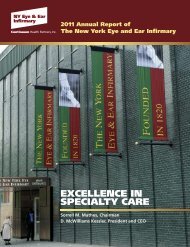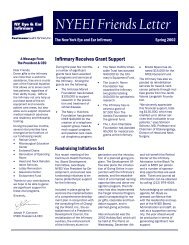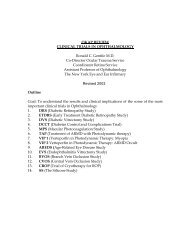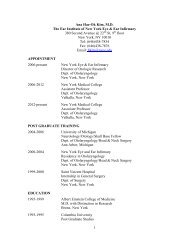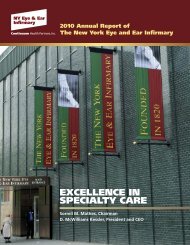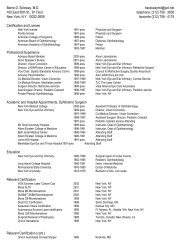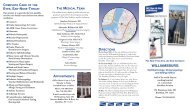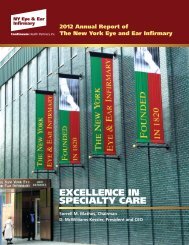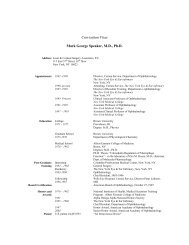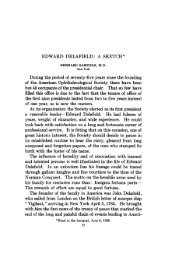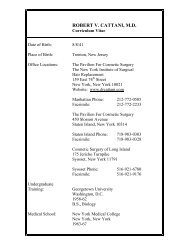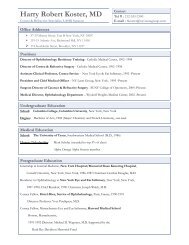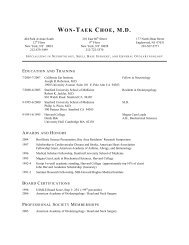BOARD and OKAP REVIEW COURSE Immunology: Uveitis
BOARD and OKAP REVIEW COURSE Immunology: Uveitis
BOARD and OKAP REVIEW COURSE Immunology: Uveitis
Create successful ePaper yourself
Turn your PDF publications into a flip-book with our unique Google optimized e-Paper software.
<strong>BOARD</strong> <strong>and</strong> <strong>OKAP</strong> <strong>REVIEW</strong> <strong>COURSE</strong><br />
<strong>Immunology</strong>: <strong>Uveitis</strong><br />
Lawrence V. Najarian, M.D.<br />
Revised 2004
<strong>Immunology</strong> - UVEITIS<br />
Inflammation – Delicate balance between useful <strong>and</strong> harmful ocular inflammation in a structure with a low<br />
threshold for irreversible damage <strong>and</strong> limited capacity for regeneration.<br />
Non-Immune Mechanism<br />
Intact corneal epithelium <strong>and</strong> globe.<br />
Tears – Lysozyme, lactoperoxidase, lactoferrin, etc.<br />
Components of the Immune Response<br />
Antigen, Antibody, B cells, T cells complement, neutrophils, monocytes/macrophages.<br />
Antigen (Ag) – A substance capable of eliciting an immune response.<br />
S Antigen<br />
- Origins in photoreceptor region of retinal <strong>and</strong> pineal gl<strong>and</strong>.<br />
- Causes experimental autoimmune uveitis, T-cell response.<br />
- Causes bilateral uveitis when injected at sites far from the globe.<br />
- In humans, causes a condition similar to VKH <strong>and</strong> sympathetic ophthalmia.<br />
- Inflammation primarily a type-4 hypersensitivity reaction<br />
Antibody (Ab)<br />
Components<br />
- Classes defined by their 2 heavy polypeptic chains.<br />
- Antigen binds to the variable regions (Fab) defined by 2 light polypeptide<br />
chains.<br />
- Monochronal antibodies:<br />
o created by in vitro fusion of myeloma cells <strong>and</strong> antibody producing B<br />
cells producing a single, highly specific antibody.<br />
o<br />
o<br />
Antibody – produced by B cells<br />
can be used as probes to explore nature of cell surface Ag+Ab.<br />
Elisa testing – enzyme linked immuno absorbent assay.<br />
• first links an enzyme to an Ab; creates a conjugate<br />
• expose conjugate to Ag creating an Ag-Ab Enzyme complex.<br />
• then expose substrate to complex to detect presence of Ag <strong>and</strong><br />
measure reaction.<br />
- IgG<br />
o<br />
o<br />
o<br />
o<br />
o<br />
- IgA<br />
o<br />
most abundant, can fix complement<br />
only Ab to cross the placenta, maternal Ab in newborn infant<br />
important role in almost all immune reactions including bacteria.<br />
major Ab produced during re-exposure to Ag, ie., secondary or<br />
anamnestic response.<br />
performs opsionization (Igm does as well), i.e., Fab portion combines<br />
with Ag. The resulting Fab-Ab complex then triggers T cells <strong>and</strong><br />
macrophages via their Fc portion.<br />
2 nd most abundant
o<br />
o<br />
o<br />
- IgM<br />
o<br />
o<br />
o<br />
o<br />
- IgD<br />
o<br />
- IgE<br />
o<br />
o<br />
monomeric shape<br />
important role against viruses<br />
found in tears <strong>and</strong> nasal, bronchial, <strong>and</strong> GI secretions<br />
largest Ab, pentomeric shape<br />
efficient agglutinator of particulate Ag<br />
first Ab to appear in developing a Primary Immune Response.<br />
fixes complement <strong>and</strong> performs opsinization like IgG.<br />
major B cell receptor on B cell surface<br />
important role in atopic reaction<br />
has the ability to degranulate most cells.<br />
B cells<br />
- originates from bursa of Fabricius in chickens<br />
- bursal equivalent in man uncertain<br />
- Important for humoral immunity<br />
- polyclonal activation by pneumonococcus cell walls, Pockweed<br />
T cells<br />
- “Thymus” derived cells<br />
- responsible for cellular immunity<br />
- Several types:<br />
o T – Helper cells = OKT4 = CO4t = 60-80% total T cells<br />
o T – Suppressor cells = OKT8 = CO8+ = 20-30% total T cells<br />
o<br />
o<br />
o<br />
o<br />
T – Natural killer cells = Tnk, spontaneously cytotoxic<br />
Cyclosporin selectively interferes with T cell activation, particularly Th<br />
cells, inhibiting the synthesis of cytokines including interleukin 2<br />
• Inhibits chemotaxis of inflammatory cells expecially eosinphils<br />
In AIDS, see inversion of TH/TS ration<br />
T-cells secrete:<br />
• Interleukin 2<br />
• produced by Th cells<br />
• stimulates lymphocyte growth, i.e., Th, Ts, Tnc<br />
• deficient in AIDS patients<br />
o Interleukin 4<br />
• stimulates B cells <strong>and</strong> macrophages<br />
o Interferon<br />
• stimulates Class II Ag (Ir) expression on macrophages<br />
enhancing Ag presentation<br />
o<br />
Release interleukins <strong>and</strong> interferons.<br />
ACAID = Anterior Chamber Acquired Immunodeviation<br />
- Ag in the anterior chamber causes an increase in Ts cells, i.e., a suppression of<br />
T cell mediated immunity<br />
- See an intact Ab, hurmoral immune response.<br />
- Requires an intact ocular/spleenal axis, i.e., need Ag processing in the spleen<br />
for this to occur.<br />
Macrophages<br />
- mobile phagocytic cells derived from bone marrow stem cells<br />
- Secretes lysoenzyme, collagenases, elastase, etc.
- Secretes Interleuken 1 = leukocyte activating factor, which activates T cells.<br />
- Role in Ag presentation<br />
- Stimulated by intrleuken 4<br />
Immunogenetics<br />
- Major histocompatability complex (MHC) = Human Leukocyte Antigen (HLA) in man =<br />
Transplantation Antigens<br />
- Located on chromosome #6<br />
- Three major classes:<br />
o Class I = proteins found on all nucleated cells surfaces <strong>and</strong> controlled by loci A, B <strong>and</strong> C.<br />
• principal antigenic target in allograft rejection<br />
• strength of immune reaction determined by these antigens sitting on the cell<br />
surface.<br />
• recognized by Tc when attacking virally infected cells<br />
o<br />
Class II = cell surface proteins (Ia proteins) expressed by loci D/Dr also known as the Ir<br />
gene.<br />
• immune cooperation between cellular subtypes only occurs if all subtypes share<br />
the Ir (D/Dr) antigenic surface proteins.<br />
Some Ocular Diseases <strong>and</strong> their HLA Associates<br />
Disease Antigen Relative Risk<br />
Acute anterior uveitis<br />
HLA-B27 (C)<br />
HLA-B8 (BA)<br />
10<br />
5<br />
Ankylosing spondylitis<br />
HLA-B27 (C)<br />
100<br />
HLA-B7 (BA)<br />
Behcet’s disease HLA-B51 (O) (?C) 4-6<br />
Birdshot retinochoroidopathy HLA-A29 (C) 49<br />
Ocular Pemphigoid HLA-B12 (C) 3-4<br />
Presumed ocular histoplasmosis HLA-B7, DR2 (C) 11.8<br />
Reiter’s Syndrome HLA-B27 (C) 40<br />
Rheumatoid arthritis HLA-DR4 (C) 11.0<br />
Sympathetic ophthamia HLA-A11 (M) 3.9<br />
Vogt-Koyanagi-Harada disease MT-3 (0) 74.5<br />
*C-Caucasian, BA-Black American, O-Oriental, M-Mixed Ethnic study<br />
Attributions – <strong>Uveitis</strong> – fundamental <strong>and</strong> clinical practice<br />
Robert B. Nussenblatt <strong>and</strong> Alan G. Palestine<br />
- HLA B-27 positive uveitis patients tend to be younger with inflammation characterized by<br />
exuberant fibrinous reaction <strong>and</strong> unilateral non gr<strong>and</strong>umatous disease.<br />
• Long ter prognosis same as HLA-B27 negative patients<br />
• 1-6% of general population but present in 50-60% of patients with acute iritis<br />
• triad of acute iritis, spondylitis <strong>and</strong> HLA-B27 associated with:<br />
• Ankylosing spondylitis<br />
• Reiter’s Syndrome<br />
• Psoriatic arthritis<br />
• Inflammatory bowel disease<br />
Class III =<br />
o Complement
• A series of 11 serum proteins that interact in an enzymatic cascade.<br />
• leads to cell death by structural <strong>and</strong> functional alterations of cell membranes<br />
• triggered by a classic <strong>and</strong> alternate pathway<br />
• classic = triggered by the binding of Fc portions of IgM <strong>and</strong> IgG which are<br />
bound to Ag<br />
• alternate = activated by bacterial endotoxins <strong>and</strong> lipopolysaccarides<br />
derived from bacteria cell walls.<br />
• Complement fragments C3a, C4a, C5a are anaphylactic, i.e., increase vascular<br />
permeability, hence augmenting recruitment of inflammatory mediators.<br />
• C5a – chemotactic, i.e., receptor for it found in macrophages <strong>and</strong> neutrophils.<br />
Types of Immune Mechanisms <strong>and</strong> Relation to Disease<br />
o<br />
Type I = Hypersensitivity<br />
• Inciting Ag combines with IgE bound to most cells <strong>and</strong> basophils releasing<br />
vasoactive substances producing specific effects on target organs: skin = rash,<br />
lungs = asthma, blood vessels = shock.<br />
• Example: hay fever, atopic conjunctivitis<br />
o<br />
Type II = Antibody Dependent Cell Mediated Cytotoxicity (ADCC)<br />
• Ab (IgM or IgG) hooks up with Tc cell triggering a cytotoxic reaction.<br />
• Examples: ocular pemphagoid, blood transfusion reaction.<br />
o<br />
Type III = Immune Complex Disease<br />
• Ag/Ab complexes trigger the complement cascade which in turn attacks cells<br />
capable of causing tissue damage.<br />
• Examples: Arthus reaction, Behcet disease, Phacoanaphylasis, systemic lupus<br />
erythematous, rheumatoid arthritis, serum sickness<br />
o<br />
Type IV = Delayed Type Hypersensitivity = Cellular Immune Response<br />
• Mediated solely by T cells<br />
• Examples: PPD, Sarcoid, Sympathetic Ophthalmia<br />
• Response to viruses mostly mediated



